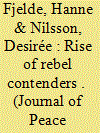| Srl | Item |
| 1 |
ID:
140920


|
|
|
|
|
| Summary/Abstract |
Fortified boundaries are asymmetrical, physical barriers placed along borders. These boundaries are more formidable in structure than conventional boundary lines, but less robust than militarized boundaries. Their goal is to impose costs on infiltrators and in so doing deter or impede infiltration. A novel dataset of all such boundaries worldwide shows that states are constructing these barriers at an accelerating rate. More than half of barrier builders are Muslim-majority states, and so are the vast majority of targets. A multivariate analysis demonstrates that, contrary to conventional wisdom, states that construct such barriers do not tend to suffer disproportionately from terrorism, nor are they apt to be involved in a significant number of territorial disputes. Instead, differences in state wealth and migration rates are the best predictors of barrier construction. Qualitative case studies suggest that the most effective fortified boundaries are found where the initiating state controls the territory beyond a boundary that blocks the only access route into the state.
|
|
|
|
|
|
|
|
|
|
|
|
|
|
|
|
| 2 |
ID:
161547


|
|
|
|
|
| Summary/Abstract |
Fragmentation of armed opposition movements through the rise of new rebel groups constitutes a significant challenge to conflict termination and peacebuilding. Yet, the question of why some rebel movements remain cohesive whereas others see a number of contending groups during the course of the armed conflict has received limited attention in existing research. This article addresses this gap by analyzing the determinants of the rise of rebel contenders in intrastate armed conflicts worldwide, 1975–2013. The theoretical framework focuses on barriers to entry, that is, variations in the costs and disadvantages that must be borne by nascent rebel contenders that are not borne to the same extent by incumbent rebel groups. The study proposes that strong social networks underpinning incumbent groups create structural barriers to entry for nascent groups by aggravating challenges of organization building. It further suggests that the interaction between incumbent groups and the government influences strategic barriers to entry as changes in government policies produce windows of opportunity for nascent groups to form. Consistent with these arguments, the study finds that when incumbent groups have strong networks – because rebels either tap into ethnic networks or draw on a leftist ideology – the risk of fragmentation is lower. Furthermore, when the government accommodates groups, through either negotiations or democratic concessions, the risk of fragmentation increases.
|
|
|
|
|
|
|
|
|
|
|
|
|
|
|
|